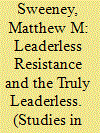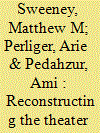| Srl | Item |
| 1 |
ID:
168891


|
|
|
|
|
| Summary/Abstract |
The literature on leaderless resistance is conceptually cloudy. Nevertheless, such literature has bounded the theoretical framework of leaderless resistance around four criteria. These criteria are leaderless resistors cannot be members of organizations they represent; leaderless resistance is a tactical manifestation of an organization; the goal of leaderless resistance is to insulate members and leaders from prosecution; and leaderless resistance arises from organizational failure. Using a case study of the Phineas Priesthood, this work tests these boundaries via a directed content analysis of the Priesthood's ideological manifesto. This research finds that leaderless resistance is theoretically problematic and too often lone wolves and leader resistors are viewed equivalent when they are theoretically different. Scholars must theoretically differentiate between individuals who ascribe to leaderless concepts, organizations, or groups versus those who develop an ideological framework and exist outside a concept, organization, or group.
|
|
|
|
|
|
|
|
|
|
|
|
|
|
|
|
| 2 |
ID:
178531


|
|
|
|
|
| Summary/Abstract |
The study explores the nexus of violence and mass media, and the ability of terrorists to enhance their influence and resources via effective marketing of their actions. We utilized a dataset of 242 IS propaganda videos in order to examine how the Islamic State employed visual propaganda to enhance the effectiveness of a low-cost, high-impact terrorist campaign, by reconstructing the theater of terror. Our findings illustrate the positive relationship between the IS territorial control and the quality of its media production, thus the IS uses propaganda to develop a relatively low-cost avenue to global media attention. Prior acts of terrorism were risky, high cost, and required news media to cover the incidents. For IS, a steady stream of battle imagery allowed it to develop highly efficient low-cost propaganda. Additionally, we identified associations between the video’s thematic components, including between level of depicted violence and the tendency of the videos to be critical or to include religious symbols, as well as their production value. It reflects the importance that terrorist groups place in maximizing the symbolic impact of their violent videos which intend to depict their military capabilities, and capacity to retaliate against their enemies.
|
|
|
|
|
|
|
|
|
|
|
|
|
|
|
|